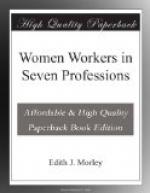There are also about 650 women employed by the Board of Trade in the Labour Exchange Service. With the exception of about 180, who were transferred from the Post Office for Unemployment Insurance Work under Part II. of the National Insurance Act, these women were admitted by the new method of recruitment adopted by the Civil Service Commissioner under Clause VII. of the Order in Council of January 1910. Under this system, applications are invited, and a certain number of apparently suitable candidates are interviewed by a committee of selection, and those chosen for appointment are subsequently required to pass a qualifying examination. The educational standard of this examination, for both men and women, is so low that it appears to be designed, not for the purpose of selecting candidates of good general education, but merely to eliminate the illiterate.
The scale of salary for these posts is the same for women as for men, and is as follows:—
Lower Grade L60, rising
by increments of L5
per annum
to L105.
Higher Grade L110, rising
by increments of
L5 per annum
to L150.
There are also a few higher appointments. Women are, however, under a particular disability in that they must wait for a vacancy in the Higher Grade before passing on beyond L105, whilst in the case of the Men Clerks there is no such stoppage, officers being allowed to proceed straight on, if certified efficient.
It will, no doubt, have been observed that the post of Women Clerk is the highest in the Service open to women by competitive examination, and with the exception of some sixteen or eighteen appointments in the Board of Education, Women Clerks have hitherto been recruited for the Post Office alone. They are now being recruited from this examination for the National Health Insurance Commissions. The exclusion of Women Clerks from the numerous State Departments such as the Home Office, Local Government Board, Inland Revenue, etc., is mainly traditional, as they are not excluded by the wording of the Order in Council of 10th January 1910 (paragraph 5, Part I.) which states that
“all appointments ... shall be made by means of competitive examinations according to regulations framed, or to be from time to time framed by the Commissioners, and approved by the Treasury, open to all persons(of the requisite age, health, character, and other qualifications prescribed in the said regulations) who may be desirous of attending the same....”
In this passage the word “persons” is interpreted to mean men only, but as other professions are yielding to the pressure of modern economic conditions and are opening their doors to women, it is time that the State considered the advisability of profiting by the services of women eminently fitted to perform clerical, organising, and administrative duties, many of whom may possess the special qualifications needed for the work in various Government Departments.




